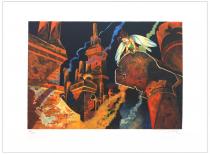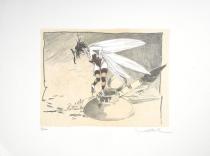Lithographs
Lithography (from Greek λίθος - lithos, 'stone' + γράφειν - graphein, 'to write') is a method for printing using a stone (lithographic limestone) or a metal plate with a completely smooth surface.
Lithography originally used an image drawn (etched) into a coating of wax or an oily substance applied to a plate of lithographic stone as the medium to transfer ink to a blank paper sheet, and so produce a printed page. In modern lithography, the image is made of a polymer coating applied to a flexible aluminum plate. To print an image lithographically, the flat surface of the stone plate is roughened slightly—etched—and divided into hydrophilic regions that accept a film of water, and thereby repel the greasy ink; and hydrophobic regions that repel water and accept ink because the surface tension is greater on the greasy image area, which remains dry. The image can be printed directly from the plate (the orientation of the image is reversed), or it can be offset, by transferring the image onto a flexible sheet (rubber) for printing and publication.
2 OEUVRE(S)





